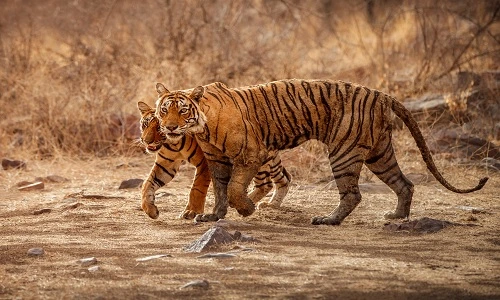Tigers: A Symbol of Pride and Conservation in India
Tigers have long been a powerful symbol of India’s pride. They represent courage and immense strength. And the magnificent beauty that nature has gifted us in these majestic creatures belonging to the cat family. Specifically, the regal Bengal tiger stands as a testament to India’s rich natural heritage for Tiger Population in India.
Consequently, India established tiger reserves under Project Tiger in 1973. The National Tiger Conservation Authority of the Government of India currently manages them.
As of December 2024, the nation boasts 57 protected areas designated as tiger reserves. Moreover, as of 2023, India is home to 3,682 wild tigers, representing nearly 75% of the world’s tiger population.
The National Animal of India: Tigers
As the national animal of India, the tiger symbolizes strength, agility, and beauty. Over the years, India has emerged as a global leader in wildlife conservation, particularly excelling in efforts to protect tigers. Notably, with close to 70% of the world’s tiger population, India’s success in conservation is a testament to the continuity and effectiveness of programs like Project Tiger.
Exploring Tiger Conservation in India
This article delves into the current state of tiger populations, the challenges they face, and the conservation measures that have made India a global model for wildlife preservation.
Tiger Population in India: Current Statistics
According to the 2022 All-India Tiger Estimation, India is home to 3,167 tigers, marking a significant increase from the 2,967 recorded in 2018. This growth is a direct result of the nation’s relentless efforts to safeguard these iconic animals. Furthermore, India’s tiger population is most prominent in regions such as Madhya Pradesh, Karnataka, and Uttarakhand, making it the country with the largest tiger population in the world.
Key Tiger Reserves in India
India’s tiger reserves, created under Project Tiger, play a crucial role in protecting these magnificent creatures. These reserves are composed of a core area—comprising parts of national parks or wildlife sanctuaries—and a buffer zone, which is a mix of forested and non-forested land. Specifically, the project aims to ensure the long-term viability of tiger populations in the core areas while promoting coexistence in buffer zones.
- Jim Corbett National Park, Uttarakhand: Known as the oldest tiger reserve, it is renowned for its diverse wildlife.
- Bandhavgarh National Park, Madhya Pradesh: Home to one of the largest populations of tigers.
- Sundarbans, West Bengal: Famous for its Royal Bengal Tigers inhabiting the mangrove forests.
- Kanha and Pench Tiger Reserves, Madhya Pradesh: Inspiration for Rudyard Kipling’s The Jungle Book.
Challenges to Tiger Conservation in India
While India has made remarkable progress in tiger conservation, several challenges persist.
- Habitat Loss and Fragmentation: With rapid urbanization and agricultural expansion, natural habitats are shrinking. This, in turn, disrupts tiger movement and breeding.
- Poaching and Illegal Wildlife Trade: Despite strict laws, tigers continue to be hunted for their skins, bones, and other body parts, fueling illegal markets.
- Human-Tiger Conflict: As tigers encroach into human settlements, conflicts arise, leading to retaliatory killings and loss of trust between local communities and conservation authorities.
- Climate Change: Rising sea levels and erratic weather patterns, particularly in ecosystems like the Sundarbans, pose unique threats to tiger habitats.
Conservation Efforts: India as a Global Role Model
India’s conservation efforts have set an example for the world through various initiatives.
- Project Tiger: Launched in 1973, it focuses on creating reserves, improving prey density, and reducing human interference.
- 54 Tiger Reserves: Spread across 18 states, these reserves account for approximately 2.4% of India’s geographical area.
- Community Involvement: Programs like Eco-Development Committees engage local communities, offering sustainable livelihoods and reducing dependence on forests.
- Technological Innovations: Tools such as GPS collars, camera traps, and drones assist in monitoring tigers and combating poaching.
Success Stories in Indian Tiger Conservation
India’s conservation efforts have yielded remarkable success stories.
- Panna Tiger Reserve, Madhya Pradesh: Once devoid of tigers due to poaching, Panna now thrives thanks to a successful reintroduction program.
- Sundarbans, West Bengal: Despite challenges like climate change, the tiger population here remains stable, supported by the unique mangrove ecosystem.
The Significance of Tiger Conservation
Tiger conservation is crucial for maintaining ecological balance, a cornerstone of sustainable life on Earth. Additionally, tigers hold immense cultural significance in Indian mythology and are revered in many parts of the country as divine symbols. Furthermore, tiger tourism significantly contributes to the economy, especially in rural areas.
Top faq for Tiger Population in India
The latest census (2022) records 3,167 tigers in India.
The Nagarjunsagar-Srisailam Tiger Reserve in Andhra Pradesh is the largest, covering over 3,500 square kilometers.
A government initiative was launched in 1973 to protect tigers and their habitats.
Yes, tigers are classified as endangered due to threats like habitat loss and poaching.
Support NGOs, adopt a tiger virtually, participate in eco-tourism responsibly, or spread awareness about conservation.
Conclusion
India’s journey in tiger conservation is a narrative of perseverance and dedication. Although challenges persist, the milestones achieved so far inspire hope for the future. By continuing to focus on robust conservation strategies, India ensures that the majestic roar of the tiger remains an enduring part of its natural heritage.





